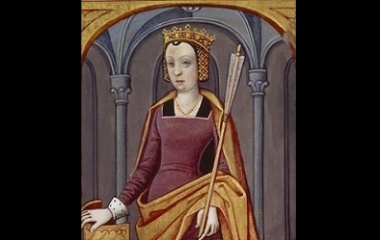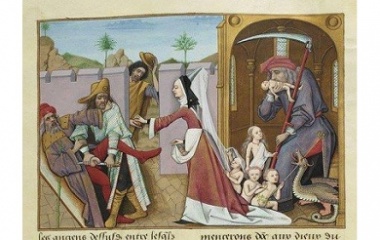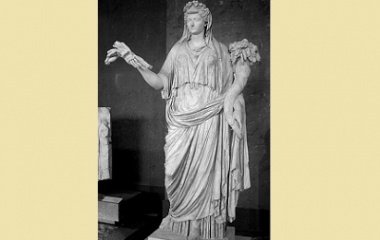- Pronunciation: AHP-s
- Origin: Roman
- Role: Goddess
- Symbols: Seeds, Bread
- Siblings: Saturn
- Children: Jupiter, Neptune, Pluto, June, Ceres, Vesta
- Other Names: Rhea, Opiconsivia
Who Is Ops?
Ops was the Roman goddess of the earth. She was a source of fertility. In general, she was a goddess of wealth and abundance as her name translates to “plenty”. She was the wife and sister of Saturn. She was the Roman version of the Greek goddess Rhea and their roles, symbols, and myths are virtually identical.
Origins
Like most Roman mythological figures, Ops was appropriated from Greek mythology. She is virtually a direct copy of Rhea.
Legends and Stories
Ops’ myth is closely related to that of Rhea and her husband Cronus. Here is the Roman interpretation of the main myth.
Baby Jupiter
Ops’ husband, Saturn, was the protector and sower. He reigned supreme in the universe but it was prophesied that one of his children would overthrow him from the throne. Saturn decided to do everything in his power and prevent this by swallowing every child that Ops bore him.
Ops wanted to protect at least one child and so when her sixth child, Jupiter, was born, Ops hid the baby and instead wrapped a stone in swaddled clothing. Saturn thought that the rock was his new son and promptly swallowed him like he had his other children. The baby was safe and raised far away to protect him.
But when Jupiter was grown, he decided it was time to overthrow his father and take control. He also wanted to save his other siblings. So, he secured the job of cup-bearer to Saturn. He eventually added a potion to the cup that causes his father to vomit. When he did, his brothers and sisters were freed from his stomach.
A war then broke out between Saturn and his children. After years of battles, Jupiter eventually won the battle. As Jupiter ascended to the throne, Saturn fled from the area and settled in Rome, where he established the Golden Age. The Golden Age was a time of perfect harmony and peace, which lasted as long as he reigned.
Family
Ops was married to Saturn and together they had many children, all of which were inspired by similar gods in Greek mythology. Their children were Ceres, Pluto, Neptune, Jupiter, Vesta, and Juno.
Neptune
Neptune was the god of the sea. He was nearly identical to the Greek god Poseidon. He was also considered to be the god of horses by his Roman worshippers as his myth says he invented the horse with a single blow of his trident in a competition for the city of Athens. It is said he was the inventor of chariot-races. He is often described with dark hair and seated in a large shell as a chariot either pulled by whales or sea-horses.
Jupiter
Jupiter was the supreme god of the Roman pantheon. He was the god of light and sky and the protector of state and laws. He is associated with lightning, storms, and thunder. His wife was Juno, who was also his sister. He was linked to the Greek god Zeus. He would eventually be part of the triad of gods established by the inhabitants of Rome. He was still considered the greatest of all gods but was also linked to Juno and his daughter Minerva in power.
Pluto
Pluto was the god of the underworld and the judge of the dead. He was a close resemblance of Hades, the Greek god of the underworld. His myth is also similar. While Hades captured Persephone and made her his wife, Pluto captured Proserpina.
Ceres
Ceres was the goddess of agriculture, grain crops, motherly relationships, and fertility. She is associated with the Roman goddess Demeter. Ceres was very important to Roman mythology as she was the only god who was involved with mortals on a day-to-day basis. She was beloved for her service to mankind. She taught humans how to grow, preserve, and prepare corn and other foods.
Vesta
Vesta was the goddess of the hearth, domestic life, and the home. She was the oldest of Ops’ children but the last to be released from her father’s stomach. Therefore, she is considered to be both the oldest and youngest. She was very attractive and many men fought for her hand. She rejected them all though and begged Jupiter to allow her to remain a virgin. He agreed and to thank him, Vesta took care of his home. This is what lets her be identified with domestic life and tranquility.
Juno
Juno was the protector and special counsel of the state. She was married to Jupiter and together they had Mars and Vulcan. Juno was responsible for the welfare of the Roman women.
Appearance
The appearance of Ops is a direct representation of what she oversees. She is usually shown as a motherly figure with long flowing hair, often in a field or meadow surrounded by flowers and greenery. In some, she is nursing a baby, showing her connection to fertility and nurturing.
Ops usually has a calm and serene look at on face. Her eyes are often closed and in almost every artistic representation, whether it’s day or night out, the moon can be seen in the background
Symbology
There are many themes associated with Ops, including wealth, fertility, opportunity, and growth. There are also many symbols related to these themes, including seeds, bread, and soil. Ops is known for providing mortals with opportunities to be productive every day, whether it be with their family or what the earth can provide them with.
Worship
King Titus Tatius of the Sabine monarch mythically instituted the Cult of Ops. She then became known as the patroness of prosperity, riches, and abundance, both on a national and personal level. She was given a famous temple in the Capitolium. There was once a festival that took place in her honor during the month of August and a day in December was typically reserved for her as well.










